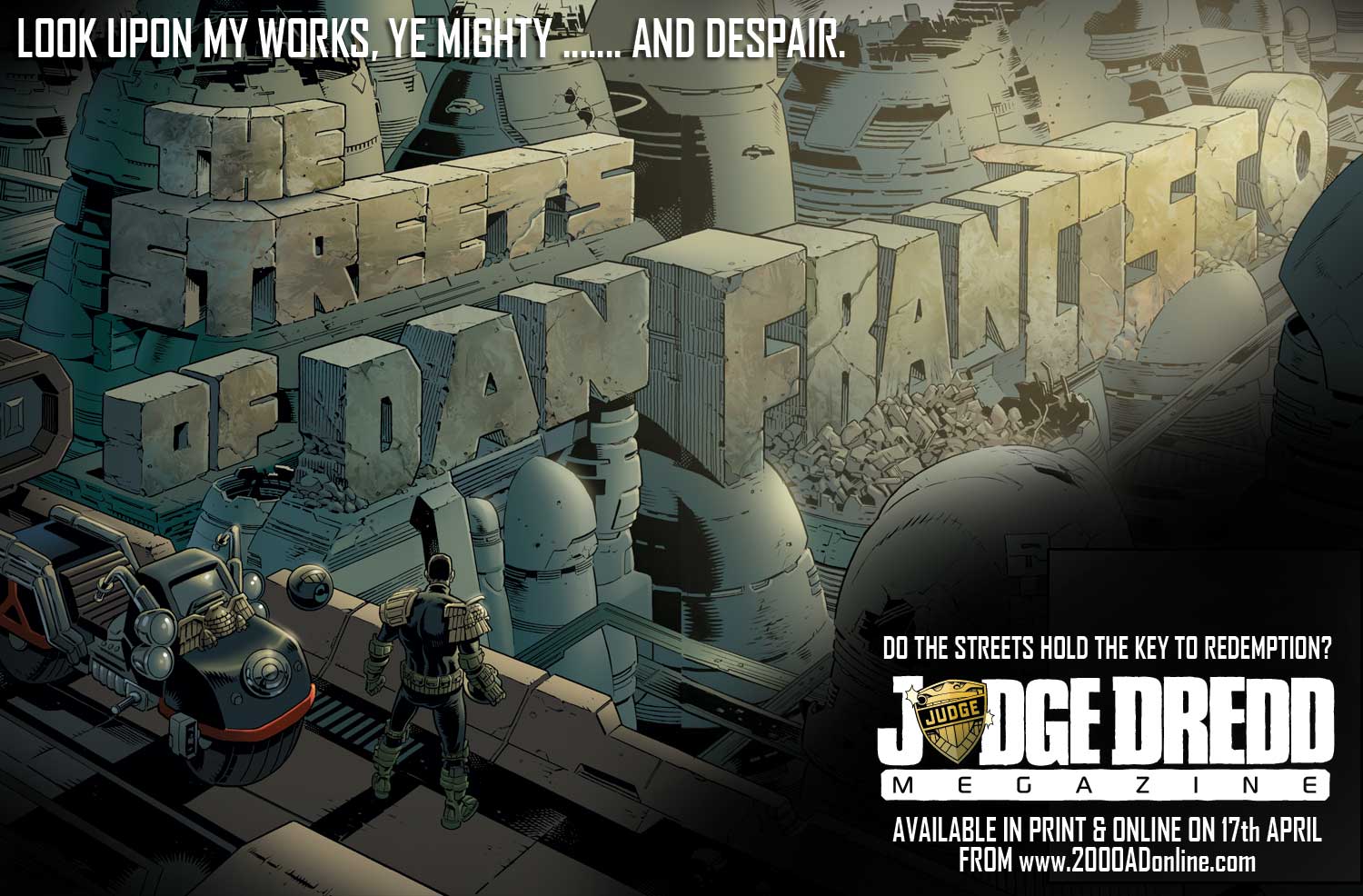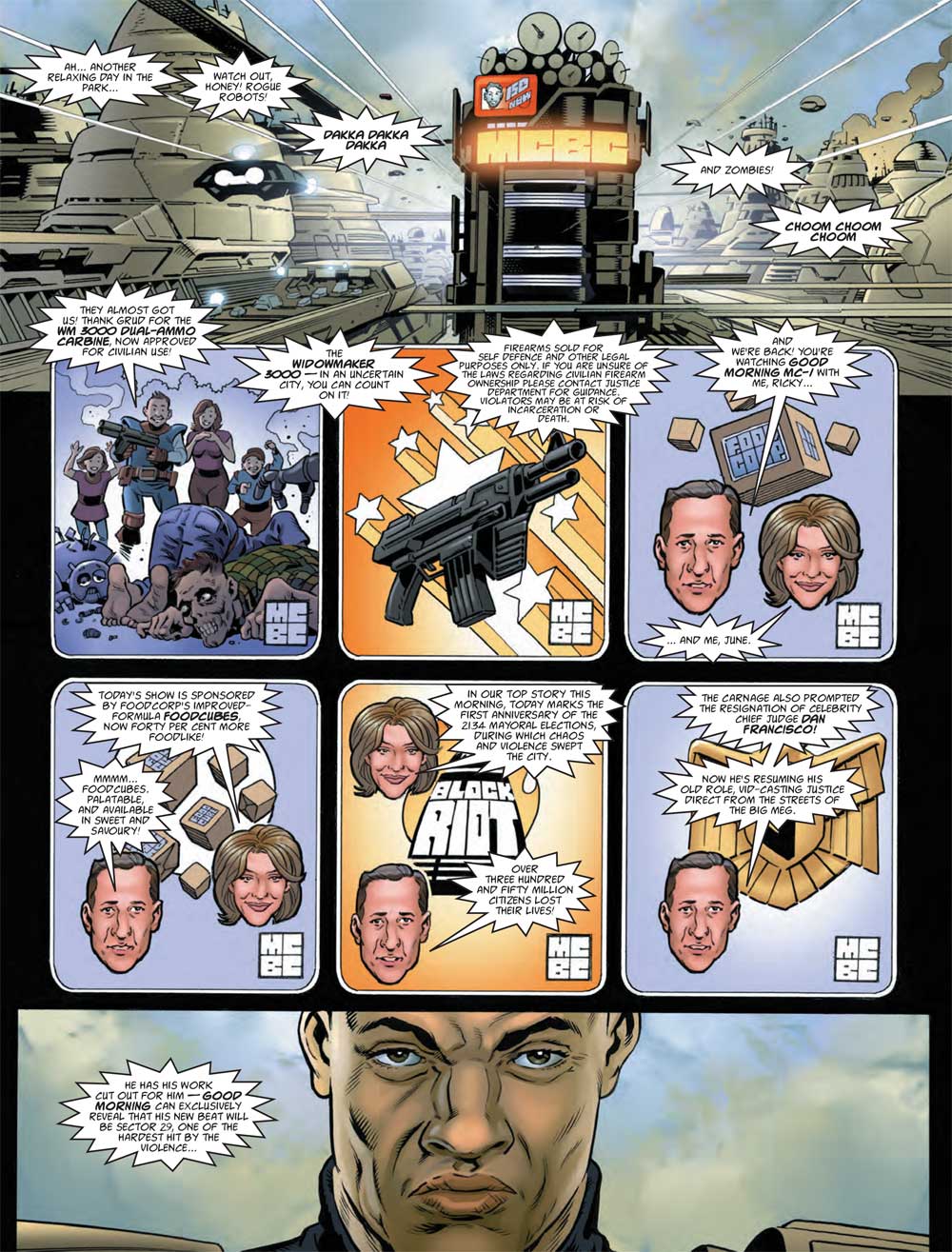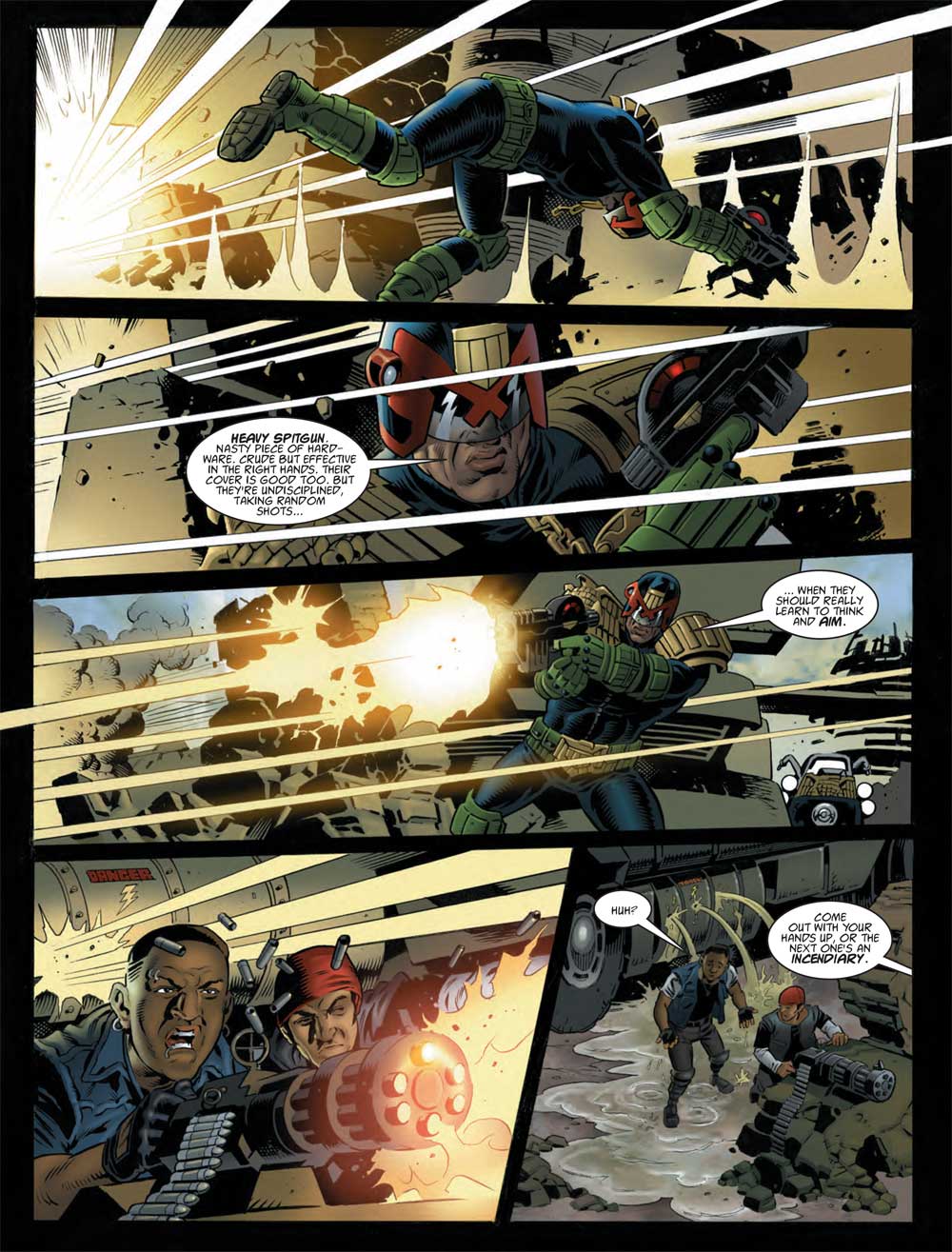Starting this week, Arthur Wyatt will be the writer for a new series in Judge Dredd Megazine which focuses on Dan Francisco, the former Chief Judge. Francisco has been one of the most prominent Judge Dredd characters for several years now, having started out as the star of his own reality TV series which proved to be so popular that he rapidly ascended to become the public face of the Judges, and eventually was elected as Chief Judge. But once there, he was unfortunate enough to be in charge during the ‘Day of Chaos’ event in which hundreds of millions of citizens were killed by a plague.
After resigning the post, the character will be returning to his role as a Judge, looking for a way to redeem himself. Wyatt, a writer who himself has been rising through the ranks of 2000AD (but has yet to preside over a Soviet attack, to my knowledge), was kind enough to walk me through the series – who is Dan Francisco, and where does he go next?
Steve: Your new series will be focusing on Dan Francisco, the public face of the Justice Department, who was unfortunately in charge of the MegaCity One when the recent ‘Day of Chaos’ event hit. What do you think lies behind the character? How do you approach him as a person?
Arthur: He’s someone who didn’t particularly want to rise to a position of power, but did anyway when others were pushing him, and while he was in that position the absolute worst happened – bad even for the standards of a city which suffers a robot rebellion, Sov invasion or visit by the Dark Judges every couple of years. And unlike those other crises, where the Judges stepped up to the challenge and though it was bad it could have been worse, in this case EVERYTHING fell apart, and EVERYONE failed, and 350 million people died. That might have happened without Francisco, but there were decisions that he made along the way that ensured it happened, and so he stood down and is back on the streets.
So he has a sense of duty, he wants to be useful, he wants to do the right thing, but now he’s burdened by crushing guilt.
Steve: Following Day of Chaos, how does his role in the city change? What brings him back into action, and what motivates him? And how do the citizens view him?
Arthur: He very much wants to go back to the way things were before he had the Chief Judge’s job, when he was a relatively carefree media figure. By going back to the streets he’s also trying to get back to what he was good at, operating at a level where he had a proven record. But every inch of the city is now a reminder of his failures, the life of a Street Judge is now stalking through ruins trying to keep starving citizens from killing each other for food.
He’s different too, more isolated, a little more grim. He now just has a camera drone instead of a crew – he’s more of a loner. Face to face conversations with citizens are different too now – he’s the guy who was Chief Judge while Mega-City One ate itself, that’s a little different from the friendly guy from the TV he once was.
Steve: You mention the media, and obviously the character was first known as the star of an in-universe reality TV show, which was used as cheap publicity for the Judges. How do you find the element of satire in 2000AD? How easy is it to juggle satire with action?
Arthur: Satire is so inherent and ingrained to 2000AD that it’s difficult to imagine a story not having an element of it even if it’s intended as straight ahead no-laughs drama.
That said if the story were all grimness all the time it would stop being fun rather quickly, so it’s nice that Francisco has this media element built in as it can always be fallen back on for a bit of a laugh. It’s a neat expository tool too – having a TV host commentary and Francisco’s constant commentary to his camera drone saves us from having too many captions just telling you what’s going on.
Steve: Do you think it’s important for characters like Dan Francisco to offer a different perspective for readers? He comes from a very different place to characters like Dredd, or Anderson.
Arthur: Dredd is the grim face of authority, telling everybody to obey the law or else because without that society will fall apart. Anderson is his anti-authoritarian balance – somehow she’s remained a part of Justice Dept but really she hates the system, doesn’t give a damn about the law, she just wants to save people. That contrast has made for a great dynamic between them in their stories over the year, not least in the recent Dredd movie which pretty much had it as its core.
Francisco is different again. He’s absolutely a part of the system, his show exists to shore up the establishment by reassuring the citizens that the judges know best. At the same time he’s a people person, he earnestly wants to be nice even if he’s sending perps to resyk with a running commentary for the viewers at home. So he’s a believer that wants everyone bar the odd criminal to be happy – even before Day of Chaos Mega-City One was not set up for that to work out well…
Steve: This story reteams you with artist Paul Marshall, who you’ve worked with before. What does his art bring to a story like this?
Arthur: Well, for me it brings a great sense of confidence! Paul knows Mega-City One inside and out, so you can throw anything at him – Judges, ruined City-Blocks, roving street gangs with automatic weapons, and he knows just how to draw it. He’s great with action scenes too, really knowing how to convey the right pace with a pages layout, so it’s possible to give him a very lean script and let him make it into something wonderful. He’s good with faces too – something that’s maybe less flashy than explosions or techno-gizmos, but vitally important if you want to tell a story with emotional depth. Being able to tell a story with facial expressions is one of those things that I think separates OK comics artists from great ones.
Steve: Which writers have inspired you when writing for 2000AD? Do you think you’ve seen your writing develop and try more experimental storytelling styles?
Arthur: For this story I think it’s pretty obvious that I’ve been hitting 80s Frank Miller pretty hard – with the media panels in particular I really wanted to get that Dark Knight Returns feel. I also wanted to emulate what he does in terms of having lots of very dense pages with small panels and then opening up to very big splashy panels for major beats.
I’ve not gone quite as crazy as I could have and tried to get one of his 16 panel grids in – artists seem horrified when I tell them I want to tell a story that way someday, for some reason. Weirdly the last place I saw a 16 panel grid, completely in the style of Miller complete with the panels being little TV screens with the dialogue underneath, was in a My Little Pony comic about Rainbow Dash. You see, artists? Kids dig it! It’s absolutely a viable way to tell stories!
Oh, and I got a big Will Eisner style double page spread in! That; I’m very pleased by.
In terms of other writers, Alan Moore looms over everyone in British comics of course, to the point where I started out copying the very verbose way he scripted things and had to unlearn a lot of stuff there. John Wagner, who is absolutely THE quintessential Dredd writer and the target you aim for despite inevitably falling short when you write for that world, is the polar opposite, with panel descriptions like “Dredd, grim” or “Dredd on a bike”.
The writers that excite me at the moment are the younger(ish) contemporary crowd like Matt Fraction, Kieron Gillen and Al Ewing. I’ve no idea what unites them except maybe a certain lightness of touch and willingness to have fun with the medium. Really I’d hope to try and be as good as those guys, have fun and experiment with storytelling along the way.
Steve: You’re perhaps most well-known for your Future Shocks – notoriously the test for writers who want to pitch for 2000AD. What do you think marks a good Future Shocks story?
Arthur: A shocking twist at the end would be the obvious, and hardest to come up with ingredient. Readers have been seeing these things for years, they know you’re building up to something – it’s going to have to be bloody amazing for them not to have outguessed you.
And then on top of that it has to be a real story – you can’t just be building up to that twist, you have an engaging world and relatable characters and action driven by the needs and desires of those characters – all of this in four to five pages!
One great tip I’ve heard, and I forget who this is, is to take that great idea you had for a twist and put it at the beginning or middle of your story, so now it’s a premise or a development along the way, and now you have to come up with something new that’s a natural development of that as an ending to work towards.
Steve: How have you found working for 2000AD as a whole – from writing the Future Shocks to now being fully involved in Judge Dredd?
Arthur: There’s an idea that there’s some kind of 2000ad career path – that you go from Future Shocks to doing a slightly longer story in the Prog (as the main 2000SD title is often called) or the Megazine and then you get your first Dredd story in the Meg and then, when you’ve really hit the big time, longer stories and maybe a Dredd story in the Prog itself.
That’s a gross oversimplification of course, and there’s plenty of writers who’ve come in on a different path, but really over the years it is roughly the path I’ve taken, and each time I hit a major point in it there’s a rather gratifying feel of “levelling up” – with achievements along the way like “first use of Drokk!” and “first comedy block name”.
I think the biggest transition has been going from writing the self-contained one-offs to multi part stories – there’s a lot of compression you need to unlearn otherwise everything ends up terribly cramped, and moving the plot along becomes less of a primary driver.
The thing I would have expected to be the biggest leap, writing stories in a shared universe rather than one I’ve invented entirely myself and using other people’s characters, was actually pretty easy. Part of that is just familiarity with 2000AD over the years – I’ve been reading on it on and off since I was a kid with the only big pause in the 90s when the discovery of music and girls intersected with a temporary dip in quality. Part of it is that the stories I first wrote in the Judge Dredd universe were Tales from The Black Museum, one-offs with a twist that were very close to the Future Shock format. It’s also a very flexible universe for storytelling, so you can do something very street level like Dan Francisco but also more obviously sci-fi stories with robots or aliens of dimension-hoping, or creepy horror like the Dark Judges or The Haunting of Sector House Nine.
So, all in all, it’s been pretty Zarjaz.
Many thanks to Arthur for his time! The Streets of Dan Francisco starts this week in Judge Dredd Megazine, which is available online as well as in stores. And Arthur himself can be found on the Twitters right here










I’m a recent Dredd fan – yes, after the recent movie with Karl Urban – starting out with Volume One as well the current Judge Dredd and Judge Dredd: Year One series, so now I’ll need to pick up and read Dan Francisco’s story! Insightful interview about what is motivating the character. The page layout examples are dynamic and varied, which I would imagine lends to the internal struggle the character is experiencing as he overcomes the guilt and finds some sense of balance to being a judge again.
Comments are closed.